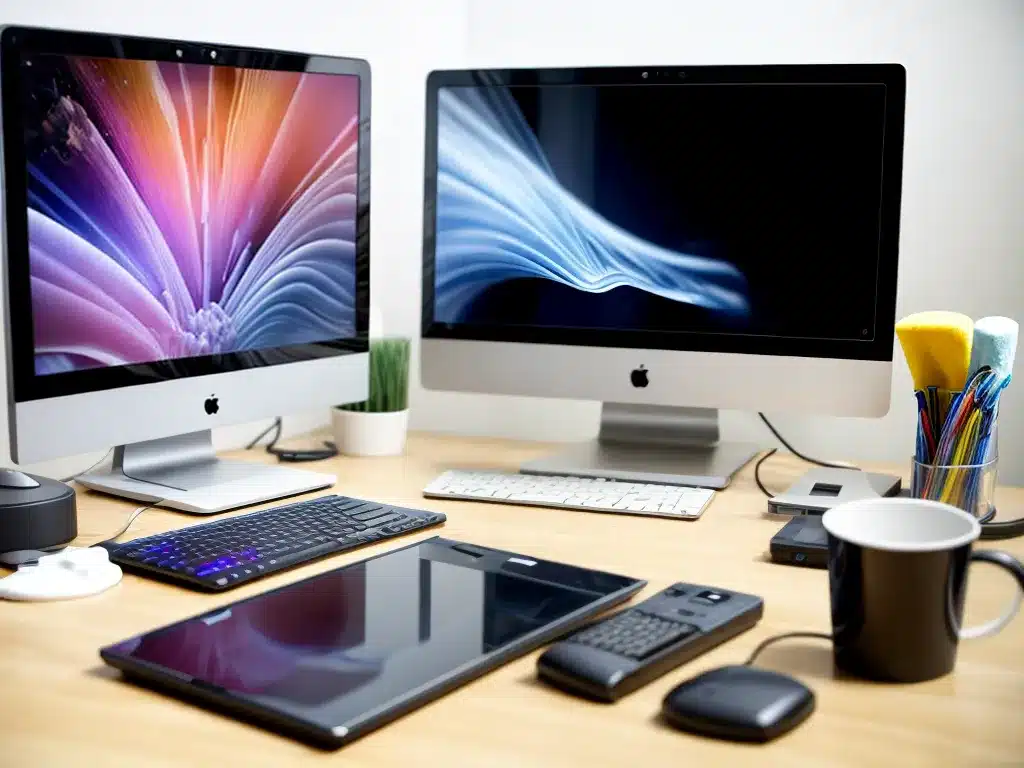
Cleaning the inside of your desktop computer regularly is important to keep it running efficiently and extend its lifespan. Here is a step-by-step guide on how to safely clean the inside of a desktop computer.
Gather Your Supplies
- Compressed air can – This is essential for blowing dust out of your computer. Make sure the can says it’s safe for electronics.
- Microfiber cloth – Use a lint-free cloth designed for cleaning screens and electronics.
- Q-tips – The cotton head on Q-tips helps reach tight spaces.
- Isopropyl alcohol – A bottle of 70% or 90% isopropyl alcohol can be used for cleaning grime.
Optional:
– Anti-static wrist strap – This helps ground yourself to prevent static buildup.
– Thermal paste – For reapplying on the CPU if you remove the heatsink.
– Phillips screwdriver – For opening up the computer case.
Power Down and Unplug the Computer
Shut down your computer through the operating system, then flip the switch on the power supply to off. Unplug all power cords from the computer and outlets. This prevents electric shock while cleaning.
Open Up the Case
Most desktop cases require removing side panels to access the inside. Look for thumbscrews on the back and sides that can easily unscrew. Lift the panels slowly to avoid snagging and damaging any wires. Lay the panels aside carefully.
If your case doesn’t have thumbscrews, look for screws that need a Phillips screwdriver. Keep the screws organized so it’s easy to put back together later.
Use Compressed Air
Hold the compressed air can upright and aim the straw attachment into any vents or perforations in the case. Hold fans in place as you spray them so they don’t spin fast. The compressed air will blow out a lot of dust bunnies.
angle air into heat sinks on components like the CPU and graphics card. Blow air through RAM slots and along the motherboard. Go slowly and be systematic to make sure you hit every area.
Clean With Microfiber Cloths
Wipe down exterior surfaces with a dry microfiber cloth to dust off. For grimier spots, add a spritz of isopropyl alcohol onto the cloth. Gently rub the damp cloth on surfaces to cut through grime.
Use cotton Q-tips dipped in alcohol for getting into small spaces. Swab down both sides of components like RAM sticks.
Check All Connections
As you clean, check that components are still securely seated in their sockets. If your graphics card or RAM got bumped loose, firmly press to reseat.
Examine wires and power connectors to ensure none worked loose. Push SATA and power cables back into place as needed.
Remove and Clean Fans
Desktop computer fans accumulate a lot of dust. You can unscrew case fans to clean the blades and compartments better. Hold the fan center to avoid bending blades while spraying compressed air.
Reinstall fans using the supplied screws. Remember fan direction – air should flow from front to back to properly ventilate.
Wipe Down the Power Supply
Unscrew and slide out the power supply. Use compressed air and a microfiber cloth lightly dampened with isopropyl alcohol to thoroughly clean the unit. Allow to fully dry before putting back into the computer case.
Replace Computer Side Panels
Carefully realign the side panels with the computer case and press into place. Replace any retaining thumbscrews or Phillips head screws. Do not force panels that won’t align – check for obstructions first.
Reconnect Power and Reboot
Plug power cords back in and flip the power switch to on. Press the power button to boot up the computer. It should power on normally without any issues. Check fans and lights as indicators it is functioning properly again.
Tips for Computer Cleaning
- Clean computers every 6 months minimum for optimal performance.
- Use circular motions when wiping components with cloth.
- Hold fans still when using compressed air to prevent damage.
- Reapply thermal paste if you remove the CPU heatsink.
- Wear an anti-static wrist strap if you have one available.
- Remove power cords before cleaning to prevent electric shock.
- Don’t attempt to clean inside a laptop or tablet.
Thoroughly cleaning the inside of your desktop computer keeps components clear of dust and ensures proper ventilation. Following this cleaning guide helps extend the life of your computer.












